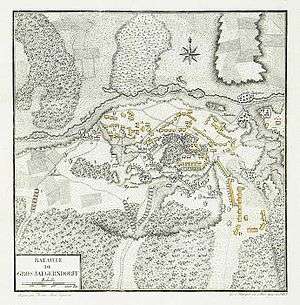Battle of Gross-Jägersdorf
| Battle of Gross-Jägersdorf | |||||||
|---|---|---|---|---|---|---|---|
| Part of the Seven Years' War | |||||||
 Battle of Gross-Jägersdorf | |||||||
| |||||||
| Belligerents | |||||||
|
|
| ||||||
| Commanders and leaders | |||||||
|
|
| ||||||
| Strength | |||||||
| 25,500 men[1] | 75,000 men[2] | ||||||
| Casualties and losses | |||||||
|
5,000 dead and wounded 28 cannons[3] | 5,400 dead and wounded[4] | ||||||
The Battle of Gross-Jägersdorf (30 August 1757) was a victory for the Russian force under Field Marshal Stepan Fedorovich Apraksin over a smaller Prussian force commanded by Field Marshal Hans von Lehwaldt, during the Seven Years' War. Despite the tactical success and for reasons unknown, Apraksin decided not to take Königsberg and ordered to withdraw soon after the battle.[5]
Background
An invading Imperial Russian army of 75,000 men, led by Field-Marshal Stepan Fedorovich Apraksin, took Memel after a five-day bombardment and, using the fortress as a place d'armes, invaded East Prussia. Apraksin, cautious and lacking war experience, was reluctant to commit his troops to battle. Instead of marching on Wehlau, as was expected, he ordered his forces to cross the Pregel River in safety, near the village of Gross-Jägersdorf (Abandoned in 1945 and away 5 km southwest from Mezhdurechye (Norkitten) and placed on municipality of Svoboda (Jänischken, Jänichen between 1938–1945) in Chernyakhovsky District), carrying out a scorched earth policy.
Battle
A Prussian army of 25,500 men, led by Field-Marshal Hans von Lehwaldt, decided to surprise the much larger enemy and attacked a corps of men under General Vasily Lopukhin while it was crossing the Pregel. The general was bayoneted by the Prussians and died in the arms of his comrades. General Pyotr Rumyantsev, on hearing about Lopukhin's plight, scrambled through a thicket and fell upon the right wing of the Prussian infantry. Another detachment attacked the rear of Lehwaldt's army.
While the Prussians retreated slightly, the centre of the Russian army recovered from the shock of the initial assault and counter-attacked. The Kalmyk cavalry and the Don Cossacks, on the Prussian left, pretended to retreat so as to trap the attacking Prussians under heavy artillery fire.
Aftermath
By the end of the day it became clear that the Russians won the battle and the Prussians had to abandon the battlefield. The Austrians present in the Russian army reported to Vienna that it was the bloodiest battle that "the 18th century has yet seen". The Prussians lost 5,000 men, the Russians lost 5,400.
Although defeated, the Prussians achieved a surprise attack, seized a number of positions from numerically superior forces and inflicted equivalent losses. As at Zorndorf, they proved to be effective against stronger forces in close-quarter fighting. On the other hand, the Russians, as a Saxon officer remarked, "had neither time nor opportunity to form a square, and yet they did extremely well", despite being taken completely by surprise.[6]
In the aftermath of the victory, it was widely expected that Apraksin would follow up the Prussian retreat and eventually overrun all of East Prussia, but the general stopped his advance towards Königsberg and withdrew back into Russia, allegedly to support Peter III as heir to the throne.[7] Another explanation for his retreat is an epidemic of smallpox, which hit the Russian army, especially the Kalmyks, and resulted in 8.5 times more deaths than all the battles fought in 1757.
In commemoration of the 240th anniversary of the Russian victory, a panoramic painting representing the battle was installed in the Friedland Gate of Kaliningrad. The battle is also commemorated on the Transnistrian ruble.
Notes
- ↑ Spencer C. Tucker, A Global Chronology of Conflict, 2009, p. 771
- ↑ Spencer C. Tucker, 2009, p. 771
- ↑ Spencer C. Tucker, 2009, p. 771
- ↑ Spencer C. Tucker, 2009, p. 771
- ↑ Frederick II, Jean-Paul Bled
- ↑ Konstam A. Russian Army of the Seven Years War. Osprey Publishing. 1996. P. 12
- ↑ The Grand Strategy of the Russian Empire, 1650-1831. Oxford University Press. USA. 2003. P. 89
External links
- (Russian) Apraksin's report about the battle (with a map appended)
- 1757-08-30 – Battle of Gross-Jägersdorf